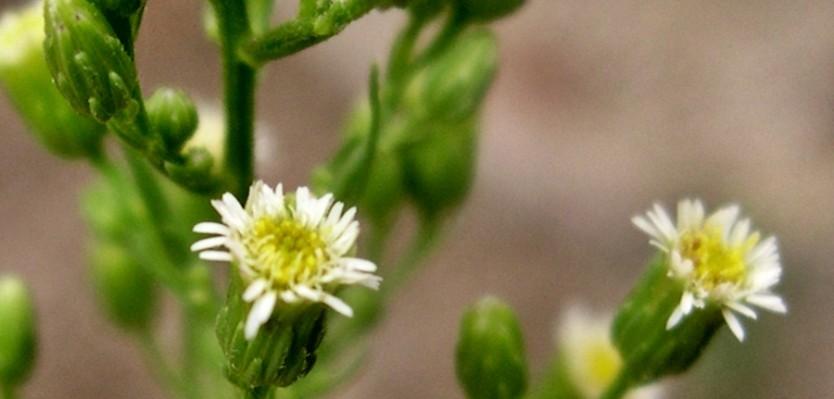
Herb up to 150 cm, with arranged flowers in small yellowish-white spherical flower heads.
Scientific name: Conyza canadensis (L.) Cronq.
Common names: Canadian fleabane, Canadian horseweed
Family: Asteraceae (Compositae)
Status in Portugal: invasive species (listed in the Decreto-Lei nº 92/2019, 10 july)
Risk Assessment score: 26 | Value obtained according to a protocol adapted from the Australian Weed Risk Assessment (Pheloung et al. 1999), by Morais et al. (2017), according to which values above 13 mean that the species has risk of having invasive behavior in the Portuguese territory | Updated on 30/09/2017.
Synonymy: Erigeron canadensis L., Erigeron pusillus Nutt., Trimorpha canadensis (L.) Lindm.
Last update: 09/07/2021
How to recognise it
Annual herb up to 150 cm, with patent hairs.
Leaves: green, glabrous or with limited hairs on the margins and the initial part of the midrib; entire or lightly dentate margins. The leaves from the base are oblong to oblanceolate; the upper ones are thinner, ellipitc to linear.
Flowers: arranged in numerous capitula, whose involucral bracts are glabrous or nearly glabrous. White or pinkish ligules, very visible.
Fruits: flattened cypselas with a pappus of 1-3 mm diameter, yellowish-white. Capitula (open) from 4-8 mm diameter.
Flowering: June to August.
Similar species
The several Conyza species in Portugal are very similar and hard to distinguish. Additionally, the Conyza species hybridize very rapidly among themselves, originating hybrids with intermediate characteristics, causing further difficulty in the identification.
Conyza canadensis is distinguished from the other species of Conyza because it presents glabrous or nearly glabrous involucral bracts. Conyza bonariensis (hairy fleabane) and Conyza sumatrensis (tall fleabane) have densely hairy bracts and very visible ligules.
Close-up of capitula: comparison of the three most common Conyza species in Portugal
Characteristics that aid invasion
It propagates by seed, producing a high amount of seeds that are efficiently dispersed by the wind, rapidly enhancing their distribution area.
Native distribution area
North America.
Distribution in Portugal
Mainland Portugal (all provinces), Azores archipelago (all islands), Madeira archipelago (island of Madeira).
Geographic areas where there are records of Conyza canadensis
Other places where the species is invasive
Europe (Spain).
Introduction reasons
Probably accidental, very ancient.
Preferential invasion environments
A ruderal weed species, very frequent in disturbed areas: urban areas, roadsides, abandoned fields, common lands, ditches and unattended crop fields (removed soils and enriched in nutrients). It also appears in natural and semi-natural areas (e.g., dunes) normally associated to disturbance events.
Impacts on ecossystems
It forms dense areas that prevent the growth of native vegetation.
Economic impacts
High costs in applying control methodologies, mainly in crop areas.
It reduces productivity in crop fields.
Other impacts
Due to the high production of pollen, it is considered an allergenic plant.
Controlling an invasive species demands a well-planned management, which includes the determination of the invaded area, identifying the causes of invasion, assessing the impacts, defining the intervention priorities, selecting the adequate control methodologies and their application. Afterwards it is fundamental to monitor the efficiency of the methodologies and recuperation of the intervened area as to perform, whenever necessary, the follow-up control.
The control methodologies used for Conyza canadensis include:
Physical control (preferencial methodology)
Hand pulling: it is applied to plants of all sizes. In more compacted substrates, hand pulling should be made during the rainy as to facilitate the removal of the root system.
Agricultural practices of soil mobilization (tilling, harrowing): it is applied to plants of all sizes when dense infestations occur. It should be done before flowering.
Chemical control
Foliar application of herbicide. Spray with herbicide (active substance: glyphosate) limiting as much as possible its application to the target species. The herbicide application should be done during the early stages of the plant’s development, before the primary axis is developed.
Visit the webpage How to Control for additional and more detailed information about the correct application of these methodologies.
Alves P, Aguiar C (2012) Três neófitos novos para a Flora de Portugal. Silva Lusitana 20 (1-2): 136-138.
CABI (2012) Conyza canadensis. In: invasive">Invasive species">Species Compendium. CAB International, Wallingford, UK. Available: http://www.cabi.org/isc/ [Retrieved 10/11/2012].
Carvalho JA, Silva L, Land EO (2008) Conyza canadensis (L.) Cronq. In: Silva L, Land EO, Luengo JLR (eds) Flora e fauna terrestre invasora na Macaronésia. Top 100 nos Açores. Madeira e Canárias, Arena, Ponta Delgada, pp. 288-290.
Dana ED, Sanz-Elorza M, Vivas S, Sobrino E (2005) Especies vegetales invasoras en Andalucía. Consejería de Medio Ambiente, Junta de Andalucía, Sevilla, 233pp.
Dufour-Dror J-M (2012) Alien invasive plants in Israel. The Middle East Nature Conservation Promotion Association, Ahva, Jerusalem, 213pp.
Flora Digital de Portugal (2012) Conyza canadensis. Available: http://jb.utad.pt/especie/conyza_canadensis [Retrieved 10/11/2012].
Marchante E, Freitas H, Marchante H (2008) Guia prático para a identificação de plantas invasoras de Portugal Continental. Imprensa da Universidade de Coimbra, Coimbra, 183pp.




